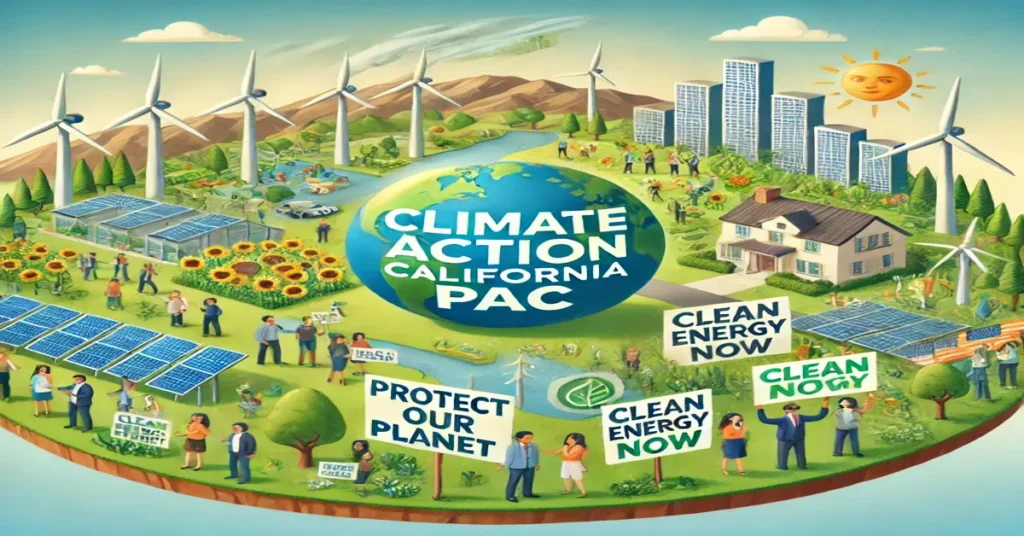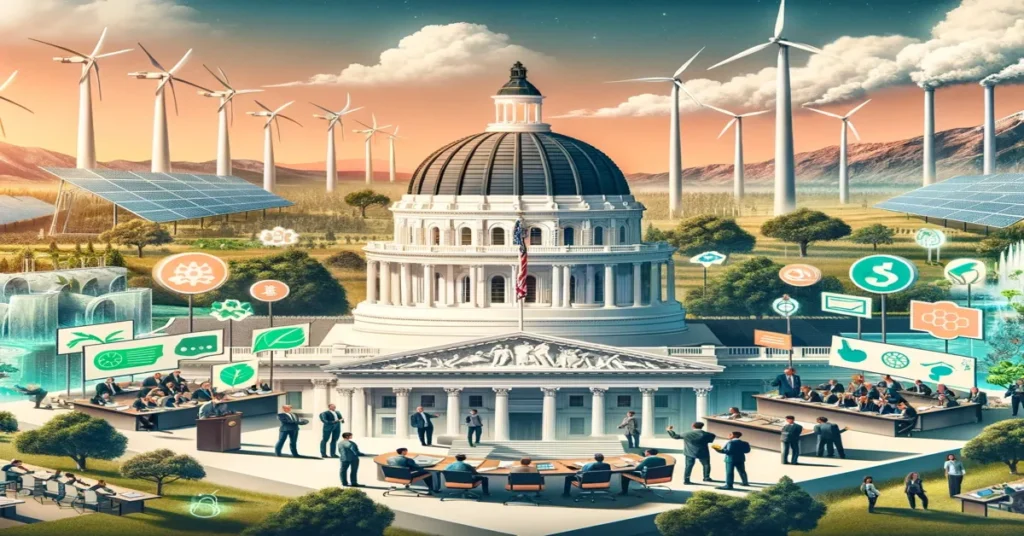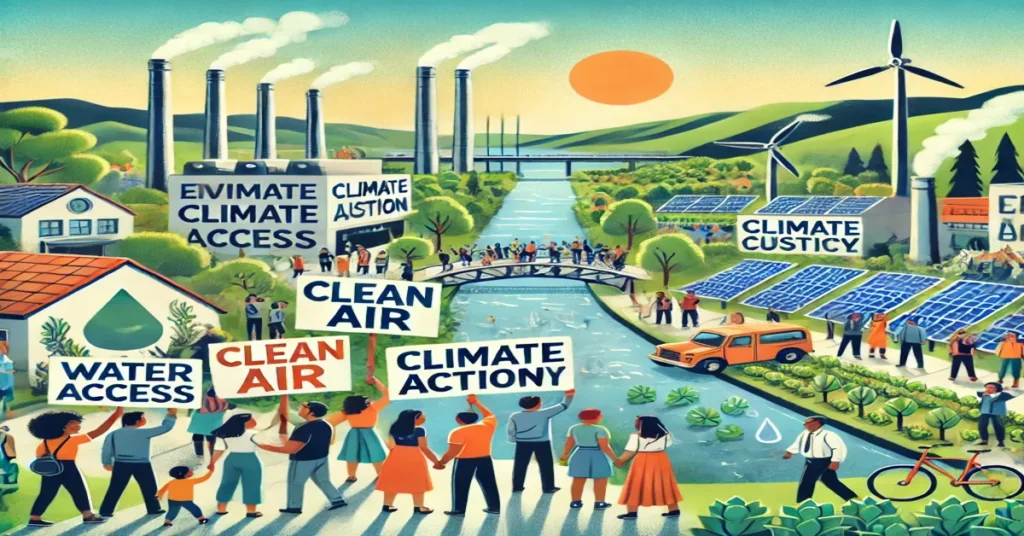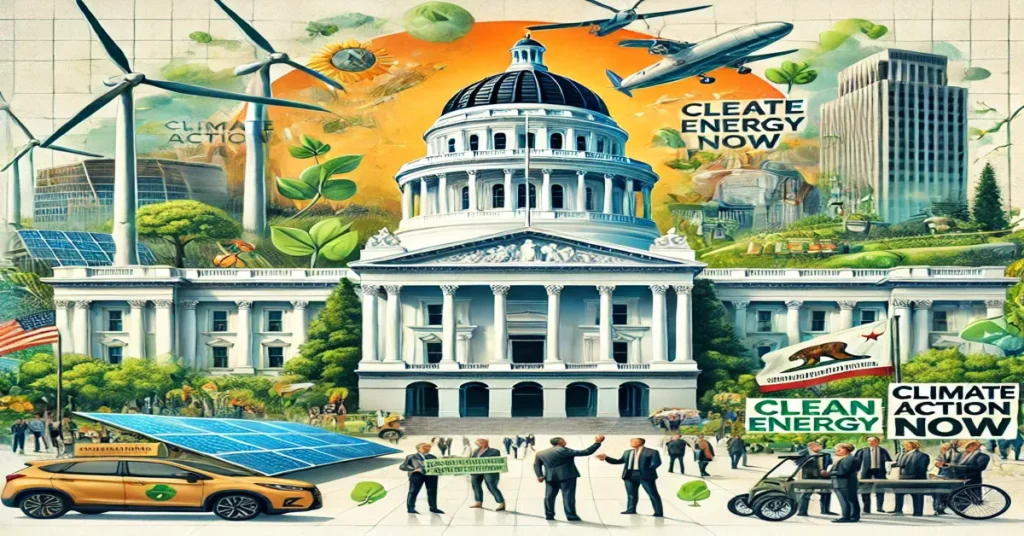Introduction
California is a global leader in environmental policy and climate action, setting ambitious goals to reduce greenhouse gas emissions, protect natural resources, and promote renewable energy. One of the key players in this movement is the Climate Action California Political Action Committee (PAC). This organization is dedicated to advancing policies that address climate change, support environmental justice, and ensure a sustainable future for the state.
In this article, we will explore the mission and role of the Climate Action California PAC, its influence on state and national policy, and the environmental issues it focuses on. We will also examine the political landscape in California, highlighting the key initiatives and legislative efforts that the PAC supports in its efforts to drive meaningful climate action.
1. The Role and Mission of Climate Action California PAC
A Political Action Committee (PAC) is an organization that raises funds to support political candidates, ballot initiatives, and legislative measures that align with their goals. The Climate Action California PAC was created to influence environmental policy by financially backing candidates and initiatives that prioritize addressing climate change, reducing pollution, and promoting renewable energy.

1.1. The Mission of Climate Action California PAC
The primary mission of the Climate Action California PAC is to push for aggressive climate action through political advocacy, campaigning, and supporting pro-environment candidates. The PAC is committed to policies that align with California’s ambitious climate goals, including reducing greenhouse gas emissions to 40% below 1990 levels by 2030 and achieving carbon neutrality by 2045.
- Climate Policy Leadership: Climate Action California PAC focuses on enacting climate policies that protect the environment, promote renewable energy, and reduce the state’s reliance on fossil fuels. This includes advocating for clean energy investments, carbon pricing, and the electrification of transportation.
- Environmental Justice: The PAC is also committed to ensuring that climate action includes protections for vulnerable communities. Many low-income and minority communities in California are disproportionately affected by air pollution, water contamination, and the impacts of climate change. Climate Action California PAC works to ensure that environmental justice is a core component of any climate policy.
1.2. Political Influence and Strategy
The Climate Action California PAC operates by using its political influence to support environmentally conscious candidates, endorse climate-friendly policies, and mobilize voters around key environmental issues. The PAC raises funds from donors, which are then used to support campaigns for candidates who demonstrate strong environmental records or commitments to fighting climate change.
- Endorsements and Campaign Contributions: One of the primary ways the PAC exerts influence is by endorsing candidates and making campaign contributions to their election efforts. These contributions help pro-environment candidates gain visibility and resources, enabling them to advocate for climate action more effectively in government.
- Grassroots Advocacy and Voter Mobilization: In addition to campaign contributions, the Climate Action California PAC works to mobilize voters around critical environmental issues. The PAC uses grassroots advocacy techniques, such as phone banking, canvassing, and digital campaigns, to engage voters and encourage them to support climate-conscious candidates and initiatives.
2. Climate Action in California: A Policy Overview
California has long been at the forefront of environmental policy, leading the nation with some of the most ambitious climate action plans. From clean energy mandates to air quality regulations, the state has implemented a range of policies aimed at reducing greenhouse gas emissions and protecting its natural environment.

2.1. California’s Climate Goals
One of the key drivers of California’s environmental policies is the state’s commitment to reducing its contribution to global climate change. In 2018, then-Governor Jerry Brown signed an executive order setting a goal for the state to achieve carbon neutrality by 2045. This means that California aims to balance the amount of greenhouse gases it emits with the amount it removes from the atmosphere.
- Carbon Neutrality by 2045: California’s carbon neutrality goal is one of the most ambitious in the world. Achieving this goal will require significant changes in energy production, transportation, and industrial practices. The state plans to achieve carbon neutrality through a combination of renewable energy investments, carbon capture technologies, and energy efficiency measures.
- Reducing Greenhouse Gas Emissions: In addition to its carbon neutrality goal, California is committed to reducing greenhouse gas emissions to 40% below 1990 levels by 2030. This target is enshrined in Senate Bill 32 (SB 32), which mandates the California Air Resources Board (CARB) to implement regulations that achieve this reduction.
2.2. Key Legislation and Initiatives
Several legislative measures and initiatives have been crucial to California’s climate action efforts. The Climate Action California PAC has been a strong advocate for these policies, using its political influence to support their passage and implementation.
- California Global Warming Solutions Act (AB 32): Passed in 2006, AB 32 is one of the foundational pieces of legislation for California’s climate policy. It requires the state to reduce its greenhouse gas emissions to 1990 levels by 2020, a target that was met and exceeded. The law also established the Cap-and-Trade Program, which sets a cap on emissions and allows companies to buy and sell emission allowances.
- Cap-and-Trade Program: The Cap-and-Trade Program is a market-based mechanism designed to reduce greenhouse gas emissions. Under this program, the state sets a cap on total emissions from covered sectors, and companies must purchase allowances to emit carbon dioxide. The revenue generated from the sale of allowances is used to fund various climate action initiatives, including renewable energy projects and public transportation improvements.
- Clean Energy Standards: California has set aggressive clean energy targets, with a mandate for the state to achieve 100% clean, renewable energy by 2045. Senate Bill 100 (SB 100), passed in 2018, requires California’s electricity grid to transition to 60% renewable energy by 2030 and 100% by 2045. The Climate Action California PAC actively supports efforts to meet and exceed these targets.
- Zero-Emission Vehicle Mandates: California is also a leader in promoting the adoption of zero-emission vehicles (ZEVs). Governor Gavin Newsom signed an executive order in 2020 requiring all new passenger vehicles sold in the state to be zero-emission by 2035. The state also offers incentives for purchasing electric vehicles (EVs) and is investing in charging infrastructure to support the transition to electric transportation.
3. Environmental Justice and Climate Action in California
While California has made significant progress in addressing climate change, the impacts of environmental degradation and pollution are not felt equally across the state. Low-income communities and communities of color often bear the brunt of air pollution, hazardous waste exposure, and the effects of climate change. The Climate Action California PAC is committed to advancing environmental justice as a core component of climate policy.

3.1. Disproportionate Impact on Vulnerable Communities
Many vulnerable communities in California live near highways, industrial facilities, and other sources of pollution. As a result, they face higher rates of respiratory illnesses, cancer, and other health problems linked to environmental hazards. Additionally, these communities are more vulnerable to the impacts of climate change, such as heatwaves, wildfires, and droughts.
- Air Pollution: Communities located near major roadways and industrial zones experience higher levels of air pollution, including particulate matter (PM2.5) and nitrogen oxides (NOx). These pollutants are linked to asthma, heart disease, and other serious health conditions. The Climate Action California PAC advocates for stricter air quality regulations and investments in clean transportation to reduce pollution in these areas.
- Climate Resilience: Climate change disproportionately affects low-income communities, who often lack the resources to adapt to extreme weather events. The PAC supports initiatives that build climate resilience, such as funding for cooling centers during heatwaves, improving infrastructure to withstand wildfires, and increasing access to clean water.
3.2. Environmental Justice Legislation
Several key pieces of legislation have been passed in California to address environmental justice and ensure that climate policies benefit all residents, not just the affluent.
- Senate Bill 535 (SB 535): This law requires that at least 25% of the revenue generated from the Cap-and-Trade Program be spent on projects that benefit disadvantaged communities. This includes investments in clean transportation, affordable housing, and renewable energy projects in low-income neighborhoods.
- Assembly Bill 617 (AB 617): AB 617 focuses on reducing air pollution in the most impacted communities by requiring local air districts to monitor and reduce pollution levels. It also requires greater community engagement in decision-making processes related to air quality and pollution reduction strategies.
4. The Political Landscape of Climate Action in California
California’s commitment to climate action has not always been smooth sailing. Political opposition, industry pushback, and economic challenges have created hurdles for climate legislation in the state. However, the Climate Action California PAC has played an instrumental role in navigating these challenges and pushing for continued progress.

4.1. Political Opposition and Industry Influence
California’s climate policies have faced opposition from various industries, including oil, gas, and manufacturing sectors, which argue that strict environmental regulations can harm the state’s economy and lead to job losses. Political opposition has also come from conservative lawmakers who view climate regulations as government overreach.
- Oil and Gas Lobbying: The oil and gas industry has spent millions of dollars lobbying against climate legislation in California. Despite the state’s goal of reducing its dependence on fossil fuels, the industry remains a powerful force in Sacramento. The Climate Action California PAC works to counterbalance this influence by supporting pro-environment candidates and advocating for stricter regulations on fossil fuel production and consumption.
- Economic Concerns: Opponents of climate action often argue that environmental regulations increase the cost of doing business in California, driving companies to relocate to states with less stringent rules. The PAC supports policies that balance environmental protection with economic growth, such as promoting clean energy jobs, supporting sustainable industries, and providing financial incentives for businesses to transition to greener practices. By advocating for a green economy, the Climate Action California PAC aims to show that economic prosperity and environmental stewardship can go hand in hand.
4.2. Building Political Coalitions for Climate Action
In California, achieving major climate goals requires strong political alliances between environmental advocates, lawmakers, and various sectors of society. The Climate Action California PAC plays a crucial role in building and maintaining these coalitions to advance climate policy.
- Collaboration with Environmental Groups: The PAC works closely with environmental organizations such as the Sierra Club, Natural Resources Defense Council (NRDC), and California Environmental Justice Alliance (CEJA) to align their efforts in pushing for climate-friendly policies. These partnerships help amplify the voice of the environmental movement and ensure that climate issues remain a priority in the state legislature.
- Engaging with Labor and Business Groups: Climate action in California often involves collaboration with labor unions and business groups to ensure that the transition to a green economy creates good-paying jobs and strengthens local economies. The PAC supports policies that promote job growth in renewable energy sectors such as wind, solar, and electric vehicle manufacturing, as well as in energy efficiency retrofitting and sustainable agriculture.
- Bipartisan Support for Climate Initiatives: While the majority of climate action support in California comes from Democratic lawmakers, the PAC also works to engage moderate Republicans who see the value in protecting California’s natural resources and reducing long-term environmental risks. By framing climate action as an economic opportunity and a public health issue, the PAC helps build bipartisan support for critical legislation.
4.3. Voter Mobilization and Climate Action
Voter engagement is an essential component of climate action in California, as public support can influence the success of climate-friendly candidates and ballot measures. The Climate Action California PAC focuses on mobilizing voters who care about environmental issues, particularly in key elections that determine the future of climate policy in the state.
- Targeting Key Elections: The PAC identifies key races at the local, state, and federal levels where climate action is at stake. By focusing resources on these pivotal elections, the PAC helps elect candidates who are committed to advancing California’s climate agenda. This includes supporting candidates for governor, state legislature, and Congress, as well as candidates for local offices like mayors and city council members.
- Public Awareness Campaigns: In addition to directly supporting candidates, the Climate Action California PAC conducts public awareness campaigns to inform voters about the importance of climate policy. These campaigns use digital advertising, social media, phone banking, and canvassing to reach voters, particularly in communities most affected by climate change and pollution.
- Ballot Initiatives and Referendums: California’s ballot initiative process allows voters to directly influence state policy on climate and environmental issues. The PAC has supported various ballot initiatives aimed at reducing greenhouse gas emissions, promoting clean energy, and increasing funding for climate resilience projects. By mobilizing voters around these measures, the PAC ensures that Californians have a say in shaping their state’s environmental future.
5. The Environmental and Economic Impact of Climate Action in California
California’s climate policies, supported in part by the Climate Action California PAC, have had a profound impact on the state’s environment and economy. From reducing air pollution to fostering a growing clean energy sector, the benefits of climate action extend beyond environmental protection to include economic growth and improved public health.

5.1. Reducing Greenhouse Gas Emissions
One of the most significant achievements of California’s climate action efforts has been the reduction of greenhouse gas emissions. Thanks to the state’s stringent regulations, investments in clean energy, and efforts to improve energy efficiency, California has successfully reduced its carbon footprint, even as its population and economy have grown.
- Decline in Emissions: Since the implementation of the California Global Warming Solutions Act (AB 32) and the Cap-and-Trade Program, the state has reduced its greenhouse gas emissions to below 1990 levels. This achievement is particularly notable given the state’s size and economic output. The continued expansion of renewable energy sources, including solar and wind, has been a key driver of this success.
- Transition to Renewable Energy: California is a leader in renewable energy, with solar power playing a central role in the state’s energy mix. The Climate Action California PAC has supported policies that encourage the development of large-scale solar farms, wind energy projects, and battery storage facilities, helping to further reduce the state’s reliance on fossil fuels.
5.2. Air Quality Improvements and Public Health
Climate action in California has also resulted in significant improvements in air quality, particularly in urban areas where smog and pollution were once major public health issues. The reduction of emissions from vehicles, industrial facilities, and power plants has had a positive impact on the health of residents, especially those living in low-income and disadvantaged communities.
- Reduced Air Pollution: The state’s aggressive policies to reduce tailpipe emissions and promote zero-emission vehicles have led to cleaner air across California. In cities like Los Angeles, which once had some of the worst air quality in the country, the transition to cleaner transportation and energy sources has dramatically reduced the levels of harmful pollutants such as nitrogen oxides (NOx) and particulate matter (PM2.5).
- Health Benefits: As air quality improves, so too does public health. Reduced pollution has led to lower rates of asthma, respiratory diseases, and other health conditions linked to poor air quality. The Climate Action California PAC advocates for continued investments in clean energy and transportation to further reduce pollution and protect public health.
5.3. Economic Growth in the Green Sector
California’s commitment to climate action has also been an economic boon, particularly in the renewable energy sector. The state has become a hub for green technology innovation, attracting billions of dollars in investment and creating thousands of jobs in industries such as solar energy, wind power, electric vehicles, and energy storage.
- Clean Energy Jobs: The growth of the clean energy sector in California has created thousands of new jobs, particularly in solar energy installation, wind turbine maintenance, and electric vehicle manufacturing. These jobs tend to be well-paying and provide opportunities for workers in both urban and rural areas.
- Innovation and Investment: California’s leadership in climate policy has positioned the state as a global center for innovation in green technology. Startups and established companies alike are developing cutting-edge solutions to reduce emissions, improve energy efficiency, and combat climate change. This innovation is not only helping California achieve its climate goals but also generating economic growth and attracting international investment.
Conclusion: The Importance of Climate Action California PAC in Advancing Sustainability
The Climate Action California PAC plays a pivotal role in shaping the future of California’s environmental policy and driving progress on climate action. By supporting pro-environment candidates, advocating for transformative legislation, and mobilizing voters, the PAC helps ensure that California remains a global leader in the fight against climate change.
As California continues to pursue ambitious goals such as carbon neutrality by 2045, the work of the Climate Action California PAC will be critical in overcoming political challenges and advancing innovative solutions to reduce greenhouse gas emissions, promote renewable energy, and protect vulnerable communities from the impacts of climate change.
The intersection of policy, economics, and environmental justice lies at the heart of the PAC’s mission, and its ongoing efforts are essential to ensuring a sustainable and equitable future for all Californians. With the continued support of the PAC and other environmental advocates, California is well-positioned to lead the world in climate action and serve as a model for other states and nations.
Read More: What Color is the Dirt in Albuquerque? Exploring the Environmental and Geological Significance

